As of 2024, there are different types of procurement routes available. Various routes are tailored to specific project needs and requirements. For those working within the construction industry, traditional routes involve processes where design and build are separated.
Contractors then bid on completed designs, and those that bid lowest, or provide the most added value typically win. However, there are less traditional routes to consider.
Procurement typically accounts for a third of public sector spending – and getting the procurement route right is a must. To find out more about the types of procurement routes available in 2024, continue reading.
The Two-Stage Procurement Route
Often referred to as two-stage contracting, two-stage procurement is when the main contractor is instructed in two parts while dealing with a construction project. The initial selection stage is the process of interested contractors being pre-qualified based on numerous criteria.
From experience to technical capability, contractors should meet the criteria accordingly. The second stage of two-stage procurement involves submitting detailed proposals, and later evaluating them. Proposals typically include cost submissions and design development.
In comparison to single-stage procurement, two-stage procurement is a less labour-intensive process for contractors. Only the preferred bidding contractor will be taken forward to the next stage during this procurement route.
The chosen bidder will assist in both the design and construction process while developing relationships with the supply chain gathering vital information.
At Procure Partnerships Framework, we aim to speed the process of two-stage procurement up as much as possible; from tender to award, the process can take anywhere between four to six weeks.
Benefits of The Two-Stage Procurement Route
There are several benefits of the two-stage procurement route. The two-stage procurement route promotes a more collaborative approach compared to alternative routes, such as single-stage procurement.
This procurement route allows clients to fully engage with potential contractors in the early stages of the process; this allows for both input and collaboration throughout the development phase.
Customers benefit from two-stage procurement the most, reaping the advantages that the contractor has to offer, such as in-depth technical expertise. With such benefits, from contractors sharing their expertise, engaging with suppliers, and promoting collaboration, this specific route is often favoured.
Additionally, two-stage procurement allows for the mitigation of risk, helping clients choose the most suitable and experienced firms, which ultimately, provides a higher chance for project success. Two-stage tendering is ideal for more complex project types, helping to ensure cost certainty while accelerating timescales for projects.
The Single-Stage Procurement Route
Typically, single-stage procurement involves setting out your project requirements before a group of contractors begin competing for the contract based on price. During single-stage procurement, the design development and construction process are separated, which can lead to increased risk.
If you happen to choose this procurement route, ensure the design process has been developed to a high standard, a realistic budget has been set, and risks have been considered before tendering.
If your project has a tight deadline or limited complexity, this procurement route might not be the best option. This is because it takes much longer to award a contractor.
While single-stage procurement doesn’t provide as much opportunity for both collaboration and innovation as two-stage procurement does, it does offer some advantages and has proven to be a good option for some.
At Procure Partnerships Framework, single-stage procurement can take up to 10 weeks, with there being a wait time of roughly one to two weeks per stage of the initial process. From then, tender to award will take between four to eight weeks, depending on project value.
Benefits of The Single-Stage Procurement Route
Single-stage procurement is relatively easy to understand, for both clients and contractors. With just one tendering stage, single-stage procurement can simplify the overall process. If you don’t require much collaboration and have ensured that the design side of your project has been sufficiently developed, then there’s not much reason for single-stage procurement not to work for you.
Although this choice is suitable for some, it’s important to note that the process of single-stage procurement involves excess admin work. However, this route could work for construction projects with straightforward requirements.
Direct Award Procurement Route
Direct award procurement is when a contract is awarded to a chosen contractor without any competition. It also occurs when there’s a material change to an already-existing contract. The process of direct award procurement is streamlined, awarding contracts to pre-selected contractors while eliminating the need for competitive tendering.
Ideal for contractors who have a proven track record of delivering quality outcomes, direct award procurement is a preferred procurement method when time constraints necessitate swift action. At Procure Partnerships Framework, direct award procurement takes just two days.
The process is straightforward and allows both professional contractors and service suppliers to be appointed to a contract quickly compared to other call-off methods. At Procure Partnerships Framework, we’ve gained great success through Direct Award, having supported 181 projects and 750 professional services appointments in total using this call-off method.
Direct Award allows public sector clients, including NHS Trusts, and Local Authorities, to name a few, to negotiate with just one single supplier as opposed to going through a highly competitive process.
Design and Build vs Build Only
Both design and build and build only offer an array of benefits, and the choice between the two often depends on factors such as client preferences, and project complexity, to name a few. While choosing between these two procurement route options, it’s vital to consider risk allocation and procurement regulations.
Design and build procurement entails the process of a main contractor being responsible for the design and construction phases throughout the project, whereas build-only procurement allows for the client to separately procure the design services from more than one consultant, before procuring the construction services through a separate contract with a contractor.
Both procurement routes have distinct approaches. Design and build provides simple communication and coordination between both design and construction teams. Streamlined communication often leads to faster project delivery, while helping lower costs with a guaranteed maximum price.
This specific procurement route allows clients the flexibility for contractors to get involved in design processes, creating a cohesive team with a single point of responsibility (the contractor).
However, although design and build procurement has its advantages in two-stage procurement routes, clients would usually avoid design and build procurement in single-stage projects as at this stage the design is already sufficiently developed.
Emerging Trends in Procurement Reform
The future of procurement routes is ever-evolving. Future procurement routes are shaping how governments approach obtaining goods and services. Under the procurement reform, new routes are being proposed.
The Procurement Act 2023 has been given Royal Assent – which means it’s the law. The regulations were laid in Parliament back in March 2024 – and it is believed that the new regulations will take effect in October 2024.
The new rules mean that any procurers will need to consider national goals and promote innovation. There’s also a new requirement for contracting bodies to acknowledge the obstacles faced by SMEs and explore ways to mitigate them.
The Competitive Flexible Procedure may involve implementing stages such as negotiation or dialogue to improve communication. The procedure will provide flexibility to contracting authorities, allowing them to design and run a process that reaches the best solution. There will be options to integrate phases throughout the process, helping to improve collaboration.
Ahead of these new changes, The Cabinet Office is starting a programme called Transforming Public Procurement (TPP). They’ve already launched their first official training product – TPP Knowledge Drops. This programme will ultimately create a more flexible, simpler commercial system that meets our needs, whilst of course remaining compliant with relevant regulations.
Which Procurement Route is Best for My Project?
Which procurement route is best for your project? There’s a lot to consider, but the experts at Procure Partnerships Framework are here to help. Compared to going down the route of open tender, we can get contractors on board quickly and compliantly.
With a tedious admin process, the tender stage can be both lengthy and time-consuming to complete. However, at Procure Partnerships Framework, we aim to ease the complexities of the typical tendering process by providing you with bespoke evaluation tools, issuing tender documentation, and managing clarifications.
Our team also remains on hand to offer commercial advice at all times. Our dedicated project delivery team offers a range of services, arranging site visits and market engagement sessions, attending interviews as non-scoring panel members, and providing helpful feedback to unsuccessful bids.
We support a wide range of clientele, working closely with local authorities, schools and academies, government departments, and emergency services, among many more.
We provide a selection of call-off methods to consider, from single-stage procurement to competition and direct award procurement, we can go through each route in greater detail, finding which option offers the best-suited benefits for you.
At Procure Partnerships Framework, we work closely with our clients to find the most suitable procurement route for them. We advise you to get in touch to book a meeting with your regional key account manager if you have a specific project in mind.
Our expert team will provide you with free advice on what procurement route is best while taking into account project specifications, timelines, and project value. To find out more, contact us today.



